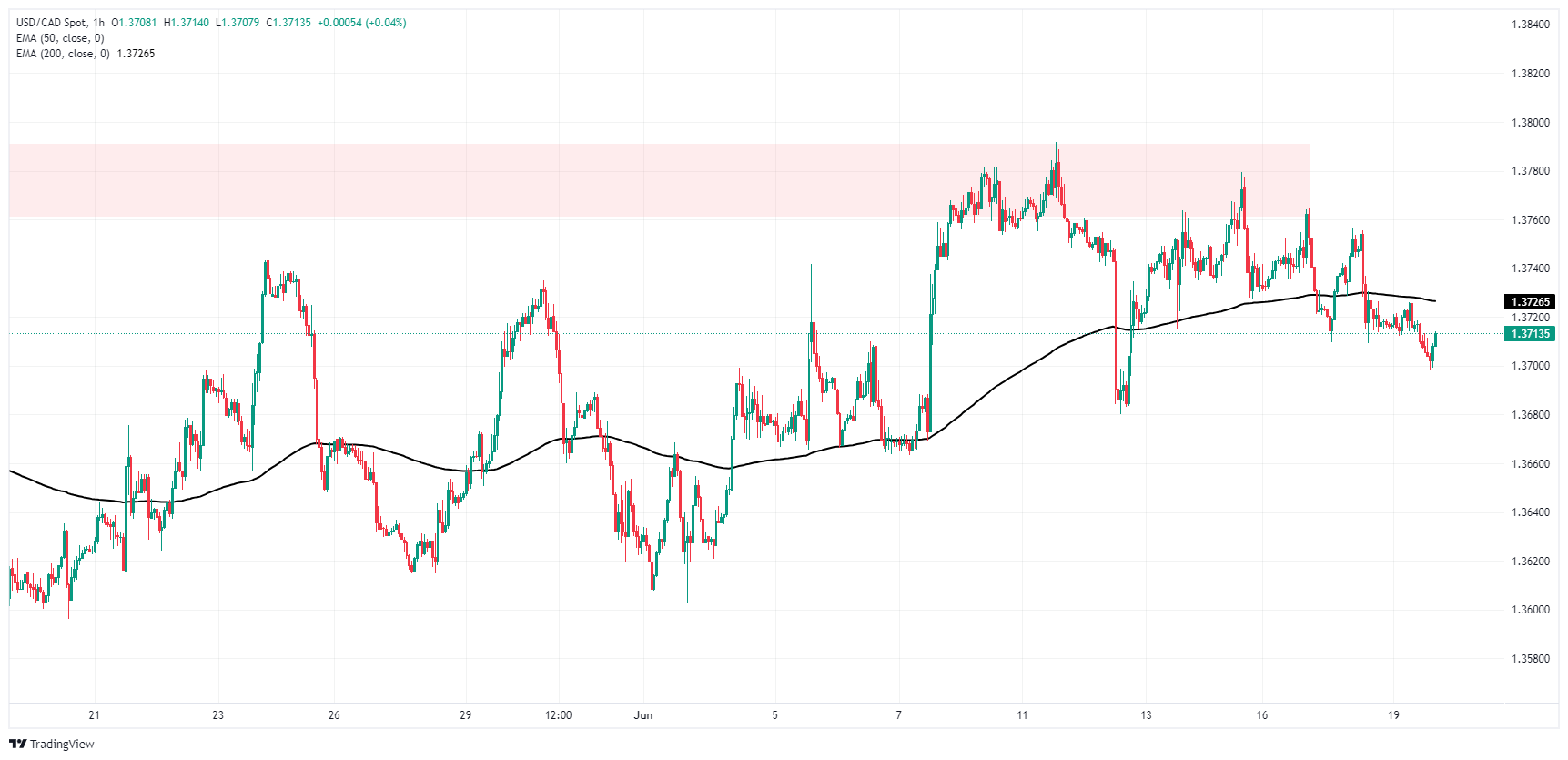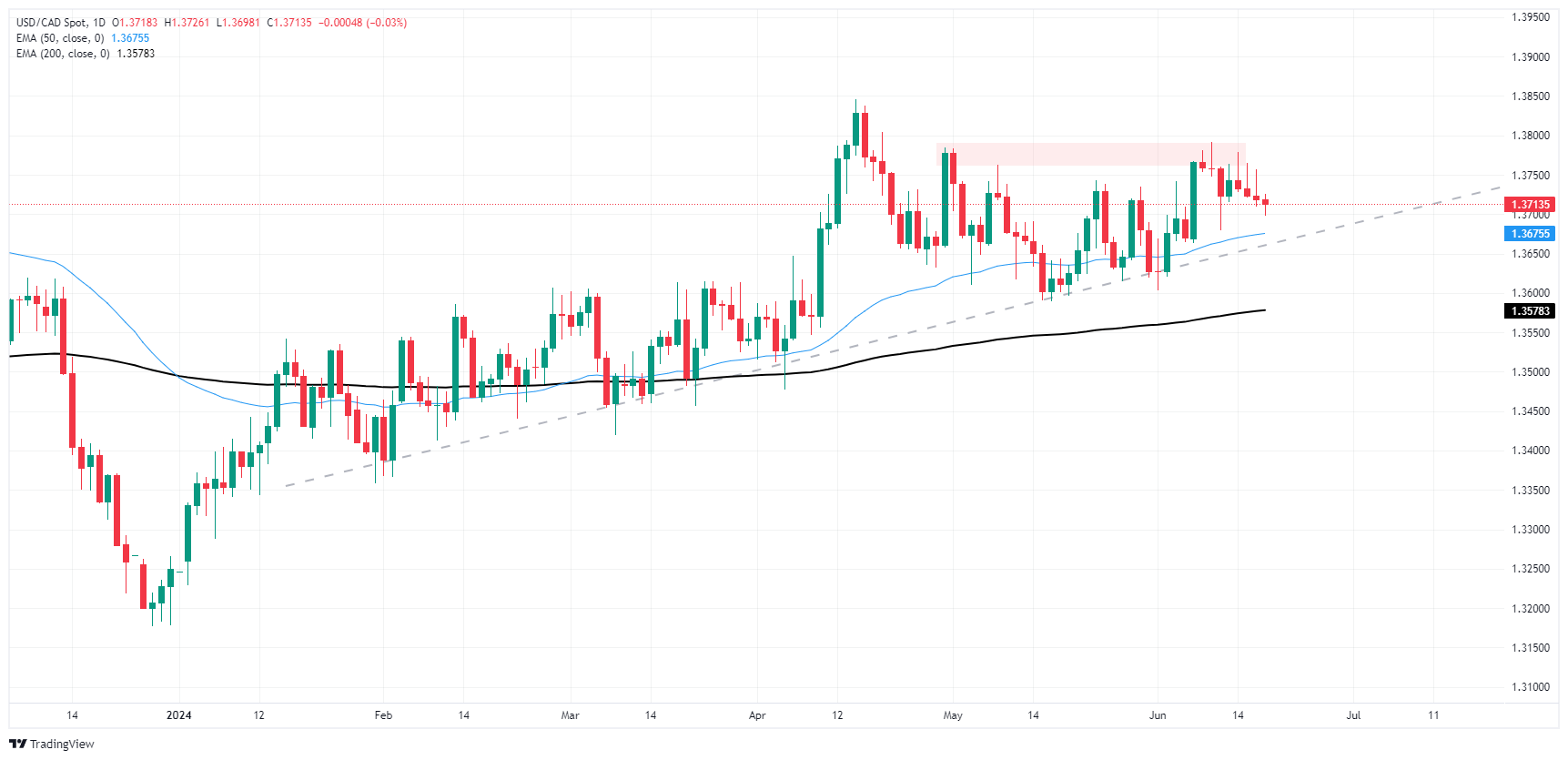- Canadian Dollar trades tightly during the mid-week market session.
- Canada relegated to strictly mid-tier data releases for the rest of the week.
- BoC Summary of Deliberations is unlikely to deliver anything new.
The Canadian Dollar (CAD) is treading water on Wednesday, trading within a scant tenth of a percent against its largest peer — the US Dollar (USD). US markets are shuttered for the midweek Juneteenth holiday, thinning out market volumes as investors look ahead to key data prints on Friday.
Canada has only mid-tier data releases on the docket for the remainder of the trading week. CAD traders will watch Wednesday’s latest Summary of Deliberations from the Bank of Canada (BoC), but no major revelations are expected. With US markets shuttered for the holiday, trading volumes are thin and investors will be returning to the fold in force to hunker down and wait for Friday’s US Purchasing Managers Index (PMI) print.
Daily digest market movers: Canadian Dollar treads water on quiet Wednesday
- The Canadian Dollar has been on a slow grind this week, finding thin gains against the Greenback. From the week’s opening bids, the CAD is up a scant fifth of a percent against the USD.
- The BoC’s Summary of Deliberations, slated for release midway through the US Wednesday session, is not expected to bring any new details to the BoC’s policy stance.
- Risk appetite is stubbornly holding on balance as investors brush off a wave of cautious talking points from Federal Reserve (Fed) officials this week. Policymakers still want to see more signs of cooling inflation in the US before committing to even discussing rate cuts.
- Interest rate markets are still staunchly committed to hopes for a September rate cut. According to the CME’s FedWatch tool, rate traders are pricing in nearly 70% odds of at least a quarter-point rate trim from the Federal Open Market Committee (FOMC) at the September 18 meeting.
- Before Friday’s US PMI print, Thursday will deliver a week-on-week update to US Initial Jobless Claims, a popular bellwether for near-term economic performance.
Canadian Dollar PRICE Today
The table below shows the percentage change of Canadian Dollar (CAD) against listed major currencies today. Canadian Dollar was the strongest against the New Zealand Dollar.
| USD | EUR | GBP | JPY | CAD | AUD | NZD | CHF | |
|---|---|---|---|---|---|---|---|---|
| USD | -0.07% | -0.09% | 0.06% | -0.04% | -0.23% | 0.20% | -0.01% | |
| EUR | 0.07% | -0.03% | 0.14% | 0.02% | -0.15% | 0.28% | 0.06% | |
| GBP | 0.09% | 0.03% | 0.16% | 0.05% | -0.13% | 0.31% | 0.10% | |
| JPY | -0.06% | -0.14% | -0.16% | -0.10% | -0.28% | 0.15% | -0.05% | |
| CAD | 0.04% | -0.02% | -0.05% | 0.10% | -0.18% | 0.25% | 0.05% | |
| AUD | 0.23% | 0.15% | 0.13% | 0.28% | 0.18% | 0.44% | 0.24% | |
| NZD | -0.20% | -0.28% | -0.31% | -0.15% | -0.25% | -0.44% | -0.21% | |
| CHF | 0.01% | -0.06% | -0.10% | 0.05% | -0.05% | -0.24% | 0.21% |
The heat map shows percentage changes of major currencies against each other. The base currency is picked from the left column, while the quote currency is picked from the top row. For example, if you pick the Canadian Dollar from the left column and move along the horizontal line to the US Dollar, the percentage change displayed in the box will represent CAD (base)/USD (quote).
Technical analysis: Canadian Dollar churns in place on Wednesday, USD/CAD finds a floor at 1.3700
The Canadian Dollar (CAD) is trading thin on Wednesday, holding close to flat against the Greenback and stuck within a fifth of a percent across the major currency board. USD/CAD eased back to the 1.3700 handle before finding a floor in the midweek markets session, but the pair is trading into the low side of median bids at the 200-hour Exponential Moving Average (EMA) near 1.3725.
Despite a lack of near-term momentum, the CAD is slowly grinding out thin gains against the US Dollar. The USD/CAD has closed flat or down for all but one of the last seven straight trading days, and Wednesday is firmly on pace to chalk in an eighth. The pair is still holding on the high side of the 50-day EMA at 1.3675 and remains trapped in bull country above the 200-day EMA at 1.3578.
USD/CAD hourly chart
USD/CAD daily chart
Canadian Dollar FAQs
The key factors driving the Canadian Dollar (CAD) are the level of interest rates set by the Bank of Canada (BoC), the price of Oil, Canada’s largest export, the health of its economy, inflation and the Trade Balance, which is the difference between the value of Canada’s exports versus its imports. Other factors include market sentiment – whether investors are taking on more risky assets (risk-on) or seeking safe-havens (risk-off) – with risk-on being CAD-positive. As its largest trading partner, the health of the US economy is also a key factor influencing the Canadian Dollar.
The Bank of Canada (BoC) has a significant influence on the Canadian Dollar by setting the level of interest rates that banks can lend to one another. This influences the level of interest rates for everyone. The main goal of the BoC is to maintain inflation at 1-3% by adjusting interest rates up or down. Relatively higher interest rates tend to be positive for the CAD. The Bank of Canada can also use quantitative easing and tightening to influence credit conditions, with the former CAD-negative and the latter CAD-positive.
The price of Oil is a key factor impacting the value of the Canadian Dollar. Petroleum is Canada’s biggest export, so Oil price tends to have an immediate impact on the CAD value. Generally, if Oil price rises CAD also goes up, as aggregate demand for the currency increases. The opposite is the case if the price of Oil falls. Higher Oil prices also tend to result in a greater likelihood of a positive Trade Balance, which is also supportive of the CAD.
While inflation had always traditionally been thought of as a negative factor for a currency since it lowers the value of money, the opposite has actually been the case in modern times with the relaxation of cross-border capital controls. Higher inflation tends to lead central banks to put up interest rates which attracts more capital inflows from global investors seeking a lucrative place to keep their money. This increases demand for the local currency, which in Canada’s case is the Canadian Dollar.
Macroeconomic data releases gauge the health of the economy and can have an impact on the Canadian Dollar. Indicators such as GDP, Manufacturing and Services PMIs, employment, and consumer sentiment surveys can all influence the direction of the CAD. A strong economy is good for the Canadian Dollar. Not only does it attract more foreign investment but it may encourage the Bank of Canada to put up interest rates, leading to a stronger currency. If economic data is weak, however, the CAD is likely to fall.
